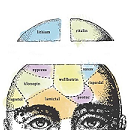ScienceNews looks at the growing use of at-home, do-it-yourself electric brain stimulation devices to improve math or problem-solving skills or help lift depression.
ScienceNews describes the devices and their effects in comparison to those of antidepressants, trans-cranial magnetic stimulation and electro-convulsive therapy.
“In a 2013 paper in the Journal of Neuroscience, Cohen Kadosh and a colleague reported that the math gains people experienced from experimental stimulation weakened a different math skill,” reports ScienceNews, while quoting Kadosh saying, “We can improve one function but it comes at the cost of another function.”
At-home brain stimulation gaining followers (ScienceNews, October 31, 2014)











